高三英语上册unit5-6教案
- 格式:doc
- 大小:47.50 KB
- 文档页数:14
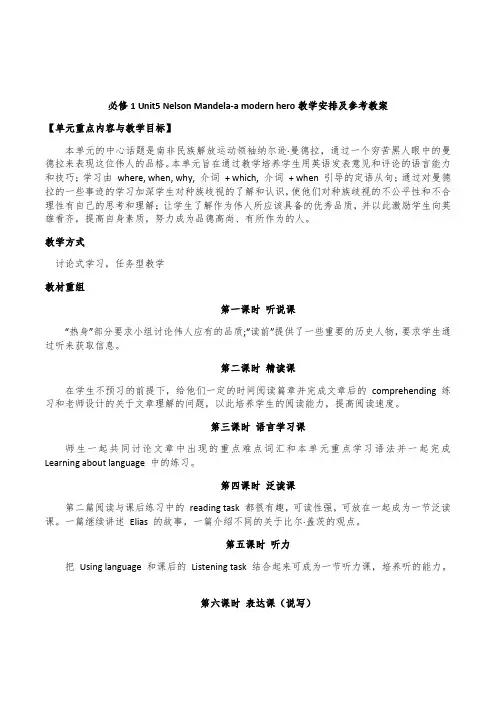
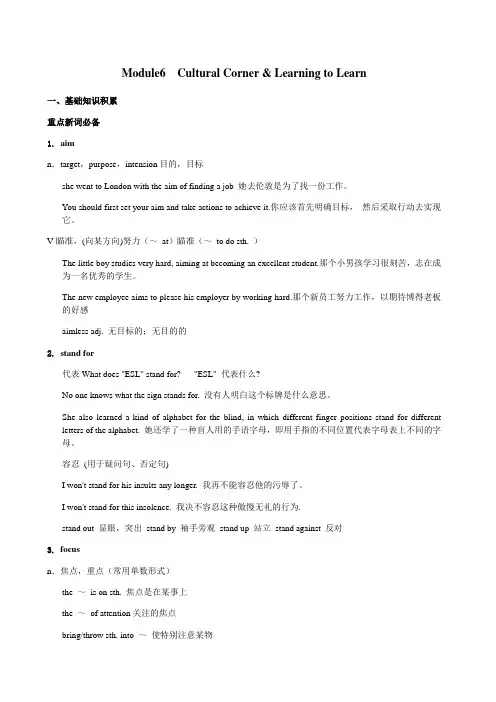
Module6 Cultural Corner & Learning to Learn一、基础知识积累重点新词必备1. aimn.target,purpose,intension目的,目标she went to London with the aim of finding a job 她去伦敦是为了找一份工作。
You should first set your aim and take actions to achieve it.你应该首先明确目标,然后采取行动去实现它。
V瞄准,(向某方向)努力(~at)瞄准(~to do sth. )The little boy studies very hard, aiming at becoming an excellent student.那个小男孩学习很刻苦,志在成为一名优秀的学生。
The new employee aims to please his employer by working hard.那个新员工努力工作,以期待博得老板的好感aimless adj. 无目标的;无目的的2. stand for代表What does "ESL" stand for? "ESL" 代表什么?No one knows what the sign stands for. 没有人明白这个标牌是什么意思。
She also learned a kind of alphabet for the blind, in which different finger positions stand for different letters of the alphabet. 她还学了一种盲人用的手语字母,即用手指的不同位置代表字母表上不同的字母。
容忍(用于疑问句、否定句)I won't stand for his insults any longer. 我再不能容忍他的污辱了。
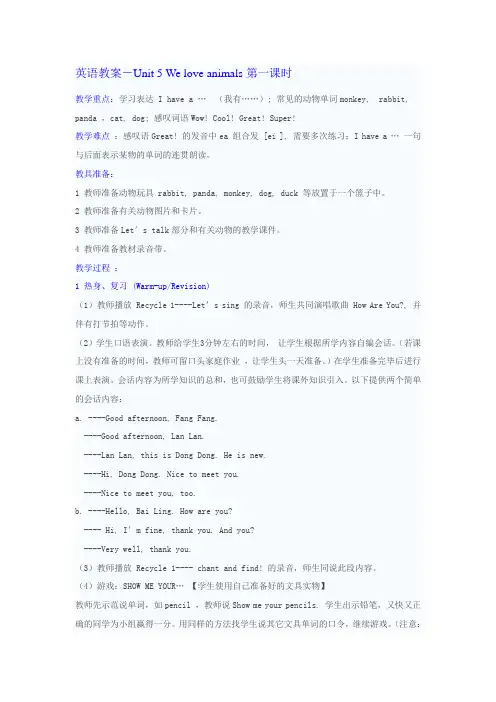
英语教案-Unit 5 We love animals第一课时教学重点:学习表达I have a … (我有……); 常见的动物单词monkey, rabbit, panda ,cat, dog; 感叹词语Wow! Cool! Great! Super!教学难点:感叹语Great! 的发音中ea 组合发 [ei ], 需要多次练习;I have a … 一句与后面表示某物的单词的连贯朗读。
教具准备:1 教师准备动物玩具 rabbit, panda, monkey, dog, duck 等放置于一个篮子中。
2 教师准备有关动物图片和卡片。
3 教师准备Let’s talk部分和有关动物的教学课件。
4 教师准备教材录音带。
教学过程:1 热身、复习 (Warm-up/Revision)(1)教师播放 Recycle 1----Let’s sing 的录音,师生共同演唱歌曲 How Are You?, 并伴有打节拍等动作。
(2)学生口语表演。
教师给学生3分钟左右的时间,让学生根据所学内容自编会话。
(若课上没有准备的时间,教师可留口头家庭作业,让学生头一天准备。
)在学生准备完毕后进行课上表演。
会话内容为所学知识的总和,也可鼓励学生将课外知识引入。
以下提供两个简单的会话内容:a. ----Good afternoon, Fang Fang.----Good afternoon, Lan Lan.----Lan Lan, this is Dong Dong. He is new.----Hi, Dong Dong. Nice to meet you.----Nice to meet you, too.b. ----Hello, Bai Ling. How are you?---- Hi, I’m fine, thank you. And you?----Very well, thank you.(3)教师播放 Recycle 1---- chant and find! 的录音,师生同说此段内容。
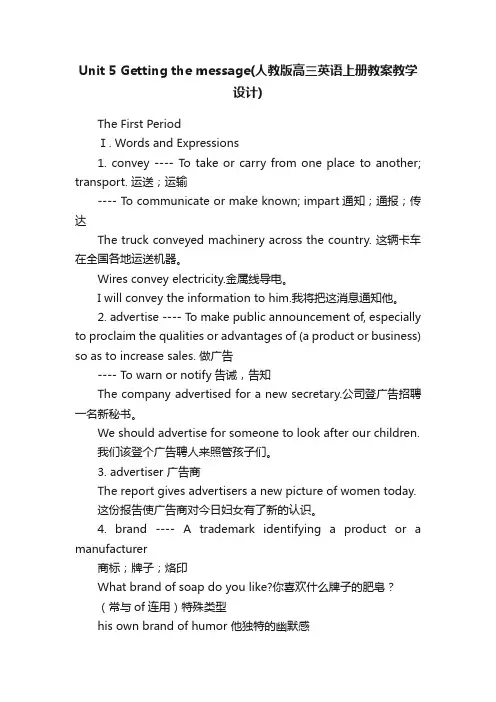
Unit 5 Getting the message(人教版高三英语上册教案教学设计)The First PeriodⅠ. Words and Expressions1. convey ---- To take or carry from one place to another; transport. 运送;运输---- T o communicate or make known; impart通知;通报;传达The truck conveyed machinery across the country. 这辆卡车在全国各地运送机器。
Wires convey electricity.金属线导电。
I will convey the information to him.我将把这消息通知他。
2. advertise ---- To make public announcement of, especially to proclaim the qualities or advantages of (a product or business) so as to increase sales. 做广告---- T o warn or notify告诫,告知The company advertised for a new secretary.公司登广告招聘一名新秘书。
We should advertise for someone to look after our children.我们该登个广告聘人来照管孩子们。
3. advertiser 广告商The report gives advertisers a new picture of women today.这份报告使广告商对今日妇女有了新的认识。
4. brand ---- A trademark identifying a product or a manufacturer商标;牌子;烙印What brand of soap do you like?你喜欢什么牌子的肥皂?(常与of连用)特殊类型his own brand of humor 他独特的幽默感These cattle have my brand on them. 这些牛身上都有我打的烙印。
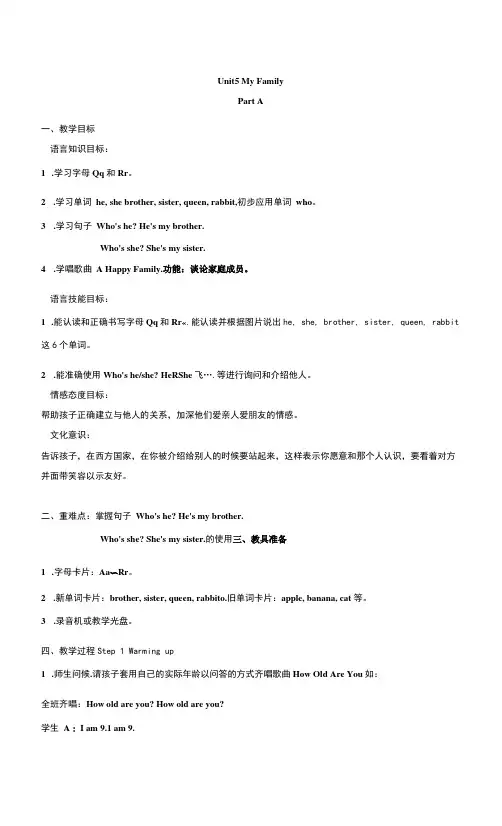
Unit5 My FamilyPart A一、教学目标语言知识目标:1.学习字母Qq和Rr。
2.学习单词he, she brother, sister, queen, rabbit,初步应用单词who。
3.学习句子Who's he? He's my brother.Who's she? She's my sister.4.学唱歌曲A Happy Family.功能:谈论家庭成员。
语言技能目标:1.能认读和正确书写字母Qq和Rr«.能认读并根据图片说出he, she, brother, sister, queen, rabbit 这6个单词。
2.能准确使用Who's he/she? HeRShe飞….等进行询问和介绍他人。
情感态度目标:帮助孩子正确建立与他人的关系,加深他们爱亲人爱朋友的情感。
文化意识:告诉孩子,在西方国家,在你被介绍给别人的时候要站起来,这样表示你愿意和那个人认识,要看着对方并面带笑容以示友好。
二、重难点:掌握句子Who's he? He's my brother.Who's she? She's my sister.的使用三、教具准备1.字母卡片:Aa〜Rr。
2.新单词卡片:brother, sister, queen, rabbito.旧单词卡片:apple, banana, cat 等。
3.录音机或教学光盘。
四、教学过程Step 1 Warming up1.师生问候.请孩子套用自己的实际年龄以问答的方式齐唱歌曲How Old Are You如:全班齐唱:How old are you? How old are you?学生A: I am 9.1 am 9.(-)揭示课题.教师出示二幅图画,一幅为黑白图画,一幅为彩色图画,画面上有蓝天、白云、草地、花朵、树木和小动物等。
通过两幅图的对比,引出单词color和colors的教学。
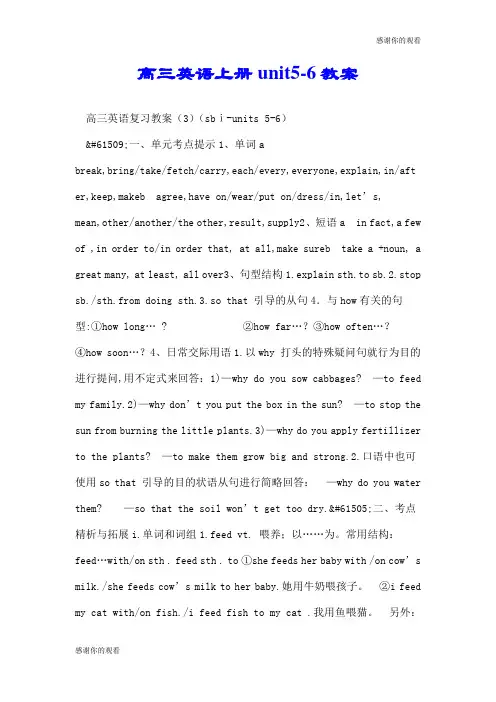
高三英语上册unit5-6教案高三英语复习教案(3)(sbⅰ-units 5-6)一、单元考点提示1、单词abreak,bring/take/fetch/carry,each/every,everyone,explain,in/aft er,keep,makeb agree,have on/wear/put on/dress/in,let’s, mean,other/another/the other,result,supply2、短语a in fact,a few of ,in order to/in order that, at all,make sureb take a +noun, a great many, at least, all over3、句型结构1.explain sth.to sb.2.stop sb./sth.from doing sth.3.so that 引导的从句4.与how有关的句型:①how long… ? ②how far…?③how often…?④how soon…?4、日常交际用语1.以why 打头的特殊疑问句就行为目的进行提问,用不定式来回答:1)—why do you sow cabbages? —to feed my family.2)—why don’t you put the box in the sun? —to stop the sun from burning the little plants.3)—why do you apply fertillizer to the plants? —to make them grow big and strong.2.口语中也可使用so that 引导的目的状语从句进行简略回答:—why do you water them? —so that the soil won’t get too dry.二、考点精析与拓展i.单词和词组1.feed vt. 喂养;以……为。
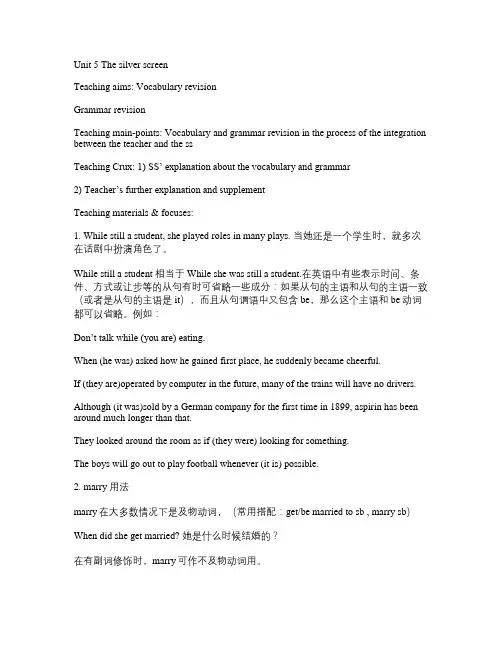
Unit 5 The silver screenTeaching aims: Vocabulary revisionGrammar revisionTeaching main-points: Vocabulary and grammar revision in the process of the integration between the teacher and the ssTeaching Crux: 1) SS’ explanation about the vocabulary and g rammar2) Teacher’s further explanation and supplementTeaching materials & focuses:1. While still a student, she played roles in many plays. 当她还是一个学生时,就多次在话剧中扮演角色了。
While still a student 相当于While she was still a student.在英语中有些表示时间、条件、方式或让步等的从句有时可省略一些成分:如果从句的主语和从句的主语一致(或者是从句的主语是it),而且从句谓语中又包含be,那么这个主语和be动词都可以省略。
例如:Don’t talk while (you are) eating.When (he was) asked how he gained first place, he suddenly became cheerful.If (they are)operated by computer in the future, many of the trains will have no drivers. Although (it was)sold by a German company for the first time in 1899, aspirin has been around much longer than that.They looked around the room as if (they were) looking for something.The boys will go out to play football whenever (it is) possible.2. marry 用法marry在大多数情况下是及物动词,(常用搭配:get/be married to sb , marry sb)When did she get married? 她是什么时候结婚的?在有副词修饰时,marry可作不及物动词用。
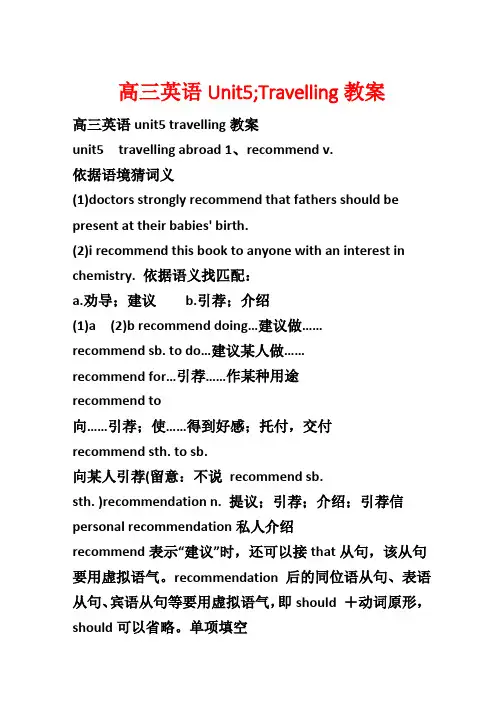
高三英语Unit5;Travelling教案高三英语unit5 travelling教案unit5travelling abroad 1、recommend v.依据语境猜词义(1)doctors strongly recommend that fathers should be present at their babies' birth.(2)i recommend this book to anyone with an interest in chemistry. 依据语义找匹配:a.劝导;建议b.引荐;介绍(1)a(2)b recommend doing…建议做……recommend sb. to do…建议某人做……recommend for…引荐……作某种用途recommend to向……引荐;使……得到好感;托付,交付recommend sth. to sb.向某人引荐(留意:不说recommend sb.sth. )recommendation n. 提议;引荐;介绍;引荐信personal recommendation私人介绍recommend表示“建议”时,还可以接that从句,该从句要用虚拟语气。
recommendation 后的同位语从句、表语从句、宾语从句等要用虚拟语气,即should +动词原形,should可以省略。
单项填空()(1)the old man should listen to the doctor's recommendation that he ______ in bed.a. stayb. staysc. stayedd. staying()(2)i can ______ him to you for the job. he is a very good worker.a. suggestb. recommendc. advised. prompt2、acknowledge vt.依据语境猜词义(1)the government must acknowledge what is happening and do something about it.(2)i would be grateful if you would acknowledge receipt of this letter.(3)we wish to acknowledge the support of the university. 依据语义找匹配:a. 答谢 b. 确认收到 c. 成认(1)c(2)b (3)aacknowledge sb. / sth. to be…成认某人/ 某物是……acknowledge that…成认……acknowledge sb. as…认为/ 承受某人是/ 成为……acknowledge doing sth. 成认做某事it is universally acknowledged that… ……是大家公认的完成句子(1)it is she who wants to acknowledge you as her daughter(认你做她的女儿).(2)he acknowledged receiving gifts (成认收过礼物)that could be seen as bribes.(3)he is widely acknowledged (普遍被认为)as the best player in the world. 3、contradict vt.依据语境猜词义(1)deborah opened her mouth to contradict,_but closed it again.(2)although these theories appear to contradict one another, each strategy has its merits and may have aspects that are suitable for certain investors.依据语义找匹配:a. (说法、真相等)与……抵触;与……冲突b. 反对;驳斥(1)b(2)acontradict yourself自相冲突contradictory adj. 相互冲突的;抵触的contradiction n. 冲突;抵触;顶嘴be contradictory to与……相冲突in contradiction with / to与……相冲突单项填空()(1)the politician's statement was contradictory______ he'd made earlier in the same week.a. to thatb. with thatc. to the oned. with one()(2)the witnesses' statements ______ each other and the facts remained unclear.a. contradictedb. comfortedc. governedd. participated4、occupy vt.依据语境猜词义(1)the smith family have occupied this farm for over a hundred years.(2)the region was quickly occupied by foreign troops.(3)members of the group occupy positions of power in the country.(4)i need some way to occupy the kids for an hour.(5)these thought occupied_my_mind,_though i tried to sleep. 依据语义找匹配:a. 占据某人的头脑 b. 使某人劳碌 c. 占着;居住于 d. (武力)占据;侵占 e. 拥有工作;担当职位(1)c(2)d(3)e(4)b(5)aoccupy oneself with sth. / doing sth.忙于……;专心于……occupy one's mind / thoughts / attention占据某人的头脑/ 思想/ 留意力be occupied(房间、座位、床位等)有人占用be occupied in doing sth. 忙于做某事be deeply occupied in thinking陷入深思be fully occupied忙得不行开交occupation n. 工作,职业;占据;消遣occupant n. 占有者;占据者翻译句子(1)他终日从事各种探究工程。
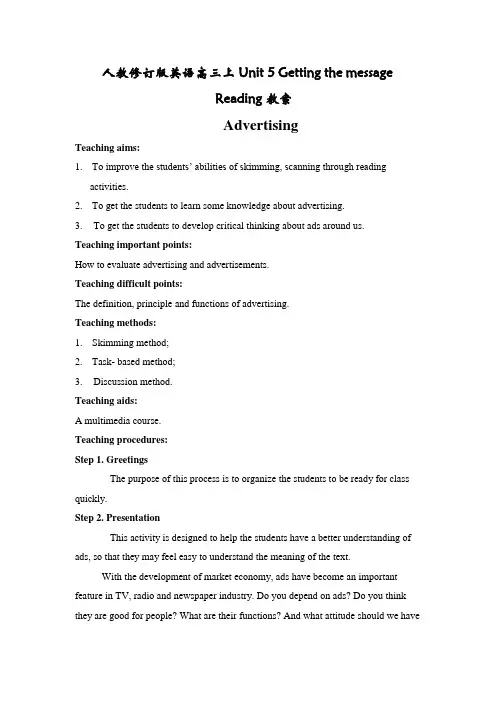
人教修订版英语高三上Unit5Getting the messageReading教案AdvertisingTeaching aims:1.To improve the students’ abilities of skimming, scanning through readingactivities.2.To get the students to learn some knowledge about advertising.3.To get the students to develop critical thinking about ads around us.Teaching important points:How to evaluate advertising and advertisements.Teaching difficult points:The definition, principle and functions of advertising.Teaching methods:1.Skimming method;2.Task- based method;3.Discussion method.Teaching aids:A multimedia course.Teaching procedures:Step 1. GreetingsThe purpose of this process is to organize the students to be ready for class quickly.Step 2. PresentationThis activity is designed to help the students have a better understanding of ads, so that they may feel easy to understand the meaning of the text.With the development of market economy, ads have become an important feature in TV, radio and newspaper industry. Do you depend on ads? Do you think they are good for people? What are their functions? And what attitude should we havetowards advertising and advertisements? Today let’s learn the whole text of ADVERTISING.Step 3. Fast reading1.Scan the text and answer the following questions.This step is designed to train the students to find the related answers of somequestions quickly.1)Where can we find ads?Answer: We can find ads almost everywhere.2)Do people react to ads in the same way?Answer: No, they don’t.3). Are all the advertisements helpful to people?No, they aren’t.2.Skim the text and try to find the topic sentence of each paragraph. Thepurpose of this activity is to help the students know how advertising is illustrated inthe text.The topic sentence is used to summarize the main idea of the paragraph or the whole passage. It usually falls at the beginning or end of the paragraph. So when we read a passage , we’d better pay more attention to the first paragraph or the first sentence. In this text, topic sentence can be found in most paragraphs.Para. 1. Ads can be found almost everywhere.Para. 2. People react to the advertisements in different ways.Para. 3. The basic principle of advertisements is to influence cus tomers’ choices.Para. 4. Ads help companies and customers in a variety of ways.Para. 5. The most important function of advertising is to introduce new products.Para. 6. Governments and other organizations use ads to make people aware of government policies and social problems.Para. 7. Customers should be careful of illegal ads.Para. 8. Customers should learn to protect themselves from false ads and make smart choices.Step 4. Careful readingThis step is designed to get the students to read the text carefully to find out more details about the whole text.Listen and tell whether the following statements are true or false.After listening, divide the students into four groups and then have discussion. Then have a competition.1. The development of radio, television and other media has not gone hand in hand with the development of advertising. F2. People respond to ads in different ways. T3. Companies use ads to influence customers by introducing a brand name to potential customers. T4.Frequent advertising increases the product sales and increases the product price. F5.All ads are used to promote a product or to increase a company’s sales. F6.Some non-profit organizations use the advertising techniques to spread knowledge, changeattitudes and improve society. T7.People should not believe what an ad says as it may have some hidden information. T8.We should be careful and distinguish between fiction and facts when we read ads. TAnswer the following questions.Divide the students into four groups and let them discuss the questions Then ask two pairs to the front, one acting as an interviewer, the other interviewee. That is to say, one asks, the other answers.1.How do people react to ads?Some people find ads useful and entertaining; Others think that they are annoying.2.How do ads help consumers and companies?Ads can make the companies increase product sales which may lead to the reducing of the price, and it can also help the customers choose among all available products.3.In what ways do ads introduce new products?Truthful ads provide good information that customers need; By explaining the features, functions and costs of a product or service, ads also allow customers to compare prices and quality; Armed with facts and figures, customers are better to deal with somearguments given by a salesman or saleswoman.4.Why are all ads not used to promote a product or to in crease a company’s profit?Because some ads aim to spread knowledge, change attitudes and improve society.5.How can we protect ourselves from misleading ads?We should be careful when reading ads, distinguish between fiction and facts and make smart choices.Step 5. DiscussionThis step is to train the students to express their own attitudes towards ads. The students are encouraged to critical on ads.Give the students some minutes to discuss.1.What’s your attitude towards advertisements in our life?A.(1.Provide information about the latest products.2.Increase product sales.3.Reduce the prices of products.)……B.(1.Mislead customers or cheat them of money.2.Give false information.3.Take too much time or space on TV.)……2.How to find information that may not be truthful in an ad?1.We should always keep an eye out for “hidden information”.2.Look at small print or colours.3.See the pictures are true or false.4.Learn to analyze ads.Step 6. WritingThis step is to train the students writing ability. Make up an ad for our school. The ad should be catchy and convey a positive message or idea.Step 7. ConcludingThis step is to summarize the main content learned in this class. Today we’ve learned the whole text of advertising. In this class, we’ve learned how advertising works and how ads affect companies and customers. We’ve also learned we should be careful when reading ads.Step 8. HomeworkThis step is to get the students to go over the material learned in this class and strengthen their basic abilities.1.Read the text again and again till fluently.2.Finish making up an ad for our school.。
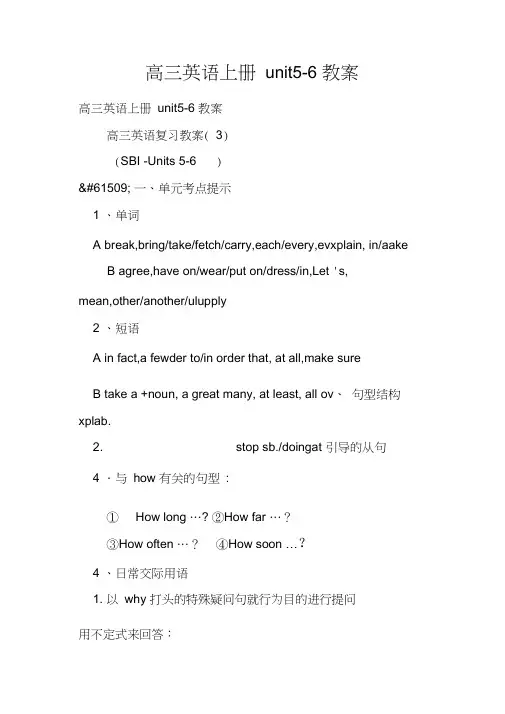
高三英语上册unit5-6 教案高三英语上册unit5-6 教案高三英语复习教案( 3)(SBI -Units 5-6 ) 一、单元考点提示1 、单词A break,bring/take/fetch/carry,each/every,evxplain, in/aakeB agree,have on/wear/put on/dress/in,Let 's,mean,other/another/ulupply2 、短语A in fact,a fewder to/in order that, at all,make sureB take a +noun, a great many, at least, all ov、句型结构xplab.2. stop sb./doingat 引导的从句4 .与how 有关的句型:①How long …? ②How far …?③How often …?④How soon …?4 、日常交际用语1. 以why 打头的特殊疑问句就行为目的进行提问用不定式来回答:1) —Why do you sow cabbages?—To feed my family.2) —Why don' t you put the boxun?—Tun from burning the little pla) —Whydo you apply fertilllants?—To magrow big and strong.2. 口语中也可使用so that 引导的目的状语从句进行简略回答:—Why do you wa?—So thal won 't get too d 二、考点精析与拓展I. 单词和词组d vt. 喂养;以……为。
常用结构:d…with/d ①She feeds her baby with /on cow ' s milk./she feeds co w' s milbaby. 她用牛奶喂孩子。
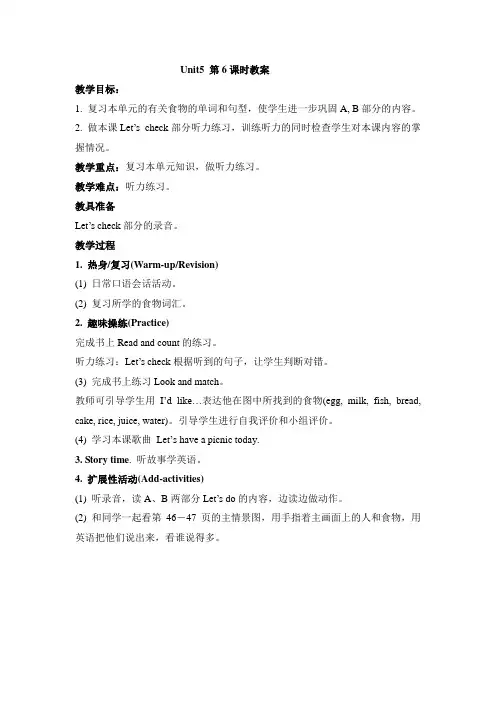
Unit5 第6课时教案
教学目标:
1. 复习本单元的有关食物的单词和句型,使学生进一步巩固A, B部分的内容。
2. 做本课Let’s check部分听力练习,训练听力的同时检查学生对本课内容的掌握情况。
教学重点:复习本单元知识,做听力练习。
教学难点:听力练习。
教具准备
Let’s check部分的录音。
教学过程
1. 热身/复习(Warm-up/Revision)
(1) 日常口语会话活动。
(2) 复习所学的食物词汇。
2. 趣味操练(Practice)
完成书上Read and count的练习。
听力练习:Let’s check根据听到的句子,让学生判断对错。
(3) 完成书上练习Look and match。
教师可引导学生用I’d like…表达他在图中所找到的食物(egg, milk, fish, bread, cake, rice, juice, water)。
引导学生进行自我评价和小组评价。
(4) 学习本课歌曲Let’s have a picnic today.
3. Story time. 听故事学英语。
4. 扩展性活动(Add-activities)
(1) 听录音,读A、B两部分Let’s do的内容,边读边做动作。
(2) 和同学一起看第46-47页的主情景图,用手指着主画面上的人和食物,用英语把他们说出来,看谁说得多。
高中三年级英语Units 5-6 (B3)【知识网络】一、重点词汇与短语1.advertise vt. & vi. 登广告,做广告I advertised my car for sale. advertise on TV/in a newspaper for sb./sth. advertise a meeting, a concert, a job 2.charge n. vt. 主管;充气(电);负责;要价;控告How much do you charge for a room with a bath? He was charged with bribery. 他被控告收取贿赂。
in charge of 负责;in (under)the charge of a person 由某人负责;take charge of 接管担任;free of charge免费地(的)3.blame vt. n. 责备,谴责,归咎于;责怪,责任blame sb. for sth./blame sth. on sb.责备某人某事be to blame for sth.(对某坏事等)负责任。
They blamed him for the accident.=They blamed the accident on him.=He was to blame for the accident.take the blame for…承担 ... 的责任4. accuse vt.控告;谴责The police accused him (of theft). He was accused ofmurder.She accused him of being late.6. get across 传播;为人理解It took me an hour to get my invention across to her.The message got across at last.7. attach vt. 系;贴;附加;认为有(重要性等)attach sth. to sth. 把某东西系到某东西上attach yourself to sb./sth. 加入;使隶属于be attach to sb./sth. 依恋;留恋8. make sense 有意义,有道理,讲得通This sentence doesn?t make sense.It makes sense to take care of your health. Can you make sense of what this writer is saying? common sense 常识;in a (some) sense 在某种意义上There is no sense in doing sth.(做某事)没道理9. keep up 维持,保持I hope the weather will keep up.The noise kept up for all night.The good news keep our spirit up.How do you keep this large house?keep an eye out for sb./sth. 留心或注意某人/ 物keep a close watch on 密切注意keep away from 避开,离开;keep back 防止,隐瞒keep on继续;keep off…离开,使不接近keep out (of)不进去,置身于夕卜,从. 离开keep up with 跟上,不落后;keep in touch with 保持联系10. beyond①prep.在..... 的那边,远于;超过I can 't see anything beyond the river because of fog.He is such a naughty boy and is beyond my control.Don't stay out beyond 10 o 'clock at night.②adv.在更远处;再往后From the top of the hill you can see a lake beyond.二、词义辨析1 . each 与everyeach 强调“个体” ,every 强调“整体” ,every 只有一个词性,形容词,且every 不接of 短语,every 只作定语,而each 作定语,主语,宾语,同位语。
全面扫描类别新课标要求重点单词 advertise advertiser consideration charge loss blame broadcast post react annoying accuse associate frequent figure salesman saleswoman profit campaign policy illegal target nowadays nephew waitress hostess bridegroom attach discount bonus quit flu circumstance assessment survival biscuit goat flour nail razor bedding beyond ox frontier salty pond burden desperate beast accustomed thirst starvation anxiety shallow tax anniversary granddaughter throat relief catastrophe deliver Arctic tough sculpture quilt packet ray bark memorial retell重点短语1. hand in hand 手拉手;密切相关地2. take…into consideration 考虑某事3. appeal to 呼吁;上诉;有吸引力4. accuse sb of (doing) sth 指控(某人)5. get across 传播;使……被理解6. keep an eye out for… 留心某人或某事7. associate with 把……联想起来8. common sense 常识;情理9. make sense 有意义;有道理10. attach to 系,贴,固定,重视11. react to 与……起反应12. make millions 赚大钱13. in charge of 负责14. think twice 三思;认真思考15. be to blame for 应受谴责;应承担责任16. at stake 在危险中17. be hard on 对…刻薄;使…难堪18. make complaints 抱怨19. be armed with 以……武装;装备20. come to an end 结束;终止21. be accustomed to 习惯于;有……的习惯22. set off for 动身;开始跑23. go for 设法得到;努力获取24. front page news 头条新闻25. in anxiety of 渴望26. keep up 保持;维持;继续27. take a close look at oneself好好反省自己28. tie up 系;拴;捆30. take it easy 别着急,别紧张语法 1. 复习宾语补足语2. 复习定语重点句型1. Thus, instead of selling them the product, the ads sometimes seem to be selling them what money cannot buy: love, happiness and success. 因此,广告推销给消费者的有时候看起来不是商品,而是用钱买不到的东西:爱心、快乐和成功。
Unit 5 Advertising 教案教学目的:掌握课文大概的内容,了解广告的作用教学重难点:如何有效的了解文章的大致内容教学步骤:Step 1 Greet ingGreeti ng and check their homeworkStep 2 Lead in1. What is the most important function of advertising? to introduce new products.2. Where can you find advertiseme nt?3. What do you thi nk of advertiseme nt?Step 3 Read ing:I . While readingun derl ine adva ntages and disadva ntages of the advertiseme nt men ti oned in the textPa1: Ads are found almost everywhereThe main idea of the paragraph is that advertis ing isa highly developedi ndustry.Pa2: People react to advertiseme nts in differe nt waysHow do people react to ads?1. Some find ads useful and en terta ining.2. Others think that they areannoying.3. Critics sometimes accuse companies of using ads to mislead us.Pa3:The basic prin ciple of advertiseme nts is to in flue nee customerschoices. Q1: Why do advertiser often have to work hard to attract people ' onattenti Because customers see so many ads every day.Q2: The best chanee to reach customers for the advertisers is to appeal to their emoti onsQ3: Is the basic principle of advertising rather difficult? No. It is fairly simple. Pa4: Ads help companies and customers in a variety of ways.Pa5: the most important function of advertising is to introduce new productsPa6: Many governments use ad campaigns to make people aware of social problems andgovernment policies.Para. 4-6 Which of the following is the main idea of this part? The advantages of ads.Pa7: We must keep an eye out for “bad-and-switch ads. (Customers should be careful of illegal ads)Q1: What is a “-abnadit-switch ” ad? It is an ad that cheats the customers byshowing them one product and then giving them another.Pa8: people should learn to analyses ads and to protect themselvesIn conclusion, we must be careful when we read ads, learn to analyse ads, and protect ourselves from false ads.川.Post-reading:1. Why is advertising popular?Because advertising can help to promote a product or increase a company's profits.2. How does advertising help consumers and customers?Frequent ads increase product sales and reduce their prices. At the same time, they help consumers choose among all the available products.3. What is the basic principle behind advertisements?I think the basic principle behind ads is that they can influence the choices customers make4. Why do advertisers often have to work hard to attract people ntion? 's atteCustomers see so many ads every day and they have to get their message across to them. 5. What is a “-anbda-istwitch ” ad?When the customer is shown one product (the bait) and then given another, that 's a -“abnadi-twitch ” ad.6. How can we protect ourselves from misleading ads?We should be careful when reading ads, distinguish between fiction and facts and make smart choices.Step 4 AnalysisAnalysis of two ads on P 41.1. Which of the techniques described in the reading passageare used to sell the product?The ad on the left provides accurate information and helps consumers make correct choices. But the one on the right is trying to mislead us by giving false or incorrect information.2. Which of the claims in the ads may not be truthful?The ad on the right may not be truthful. It says BIGBRAIN is the only nutrition supplement that has been proved to improve a child 's performance in school. I don 't think the word “only ” is properly used. Besides, it says 9 out of 10 mothoeor s ech BIGBRAIN. That can 't be true. So I think such ads shall be unpopular with customers. It does no good to the company.Homework: 1. revise the text, and underline the useful words and expressions after class2. Unit 5 同步练习。
高三英语教案 Unit FiveThe first periodPart I: DialogueTeaching ProceduresI GreetingII. Leading in the topicIII Learning some words and expressionsIV. (Teacher)Explaining briefly the key words V.ListeningA.Explain the background information of the conversationB.Listen to the tape and repeat what the students have heardVI Role-play the conversation between the Ss VII listening comprehensionVIII Do some grammar exercisesX SummaryXI Homework1.review the dialogue2.preview the textUnit FiveThe second periodPart II TextTask I: New words and expressionsTask II: General meaning of the textTeaching ProceduresI GreetingII ReviewingIII Explaining the background information of the textIV To learn the new words and expressionsV Listen to the text and get the main idea of the textVI Questions for comprehensionVII SummaryVIII. Homework1.Review the new words2.Read the text3.PrepareUnit FiveThe third periodPart III: Have the further study of the text Teaching Procedures:I GreetingII Reviewing :Read the textIII Explaining some useful phrases of the text IV To ask the students to retell the text have a discussionV Complete the sentences by translating the Chinese expression into EnglishVI Translating the Chinese sentences into EnglishVII SummaryVIII. Homework:Do Ex. In 同步Unit FiveThe fourth periodTeaching ProceduresI GreetingII Review the vocabulary and the sentence patternsIII Have a dictationIV Guided writingV Reading comprehensionA Explain the background information of the passageB Learn some new wordsC Read the passageD. Answer the questionsVI Homework:1.To review2.To do Ex.in 课课练Unit FiveThe fifth period:Check the exercises in同步课课练The sixth seventh period第五章形容词与副词一.形容词1.形容词定义2.形容词的主动或被动意义3.形容词的句法功能(1)充当定语(2)充当宾语补足语(3)充当表语4.形容词的位置(1)前置定语(2)后置定语二.副词1.副词定义2.副词的分类3.副词的作用4.副词的位置5.兼有两种形式的副词6.以ly 结尾的形容词三.形容词与副词的比较级与最高级1.形容词与副词的比较级与最高级的规则形式2.形容词与副词的比较级与最高级的不规则形式 3.一个形容词或副词有两个不同的比较级、最高级的情况4.无比较级的情况5.比较的对象6.比较的范围及基本结构7.比较级表示最高级的结构8.倍数的表达方式9.可用来修饰形容词和副词的比较级及最高级的词或短语10.most 不表示最高级的用法11.比较级的其他结构典例剖析当堂反馈作业:同步精练。
Unit 5 Getting the message I. 单元教学目标II. 目标语言III. 教材分析和教材重组1. 教材分析本单元的主题是“advertising and advertisements”,功能项目是“表示抱怨”、“表达喜怒哀乐”以及“表达、评价不同观点”,写作要点是尝试写一则广告。
通过本单元的学习,要让学生了解广告的语言特点、广告的艺术以及消费者应对广告所持的理性态度。
教师要借助听说、讨论、阅读、写作等一系列行之有效的教学活动,进一步激发学生的学习兴趣,积极参与到课堂实践中,切实提升其综合运用语言的能力,让他们意识到现代社会广告无处不在,广告是生活中不可或缺的一部分。
理性地、科学地对待广告不仅有助于提高个人素养,增添生活的乐趣,还有益于整个社会素质的提高,营造一个诚信、发展、科学、和谐的社会。
1.1 WARMING UP 提供三幅精美图片和相关广告信息,本部分可以作为下文“说”的铺垫,让学生分组讨论这些图片,唤起对“广告”这一主题的热忱和兴趣,使其有话可说,无话不说。
1.2 LISTENING有两大任务,一是根据特定的主题(选购电脑),组织学生讨论或思考,为进一步的“听”作铺垫;二是听录音,培养从听力材料中获取信息,并进行深入分析、推断、加工的能力。
1.3 SPEAKING要求把全班分成四个小组,每一组选择不同的身份和主题,结合本人的生活体验,表示抱怨、喜怒哀乐等。
作为报纸编辑,则应从全局出发,运用表示和评价不同观点的句型或结构。
这种开放式讨论有助于引导学生运用所学知识合作学习,指导他们全面地、辨证地看待问题。
1.4 PRE-READING是READING的热身活动。
要求学生以广告为话题展开讨论,初步了解广告的利与弊,为进一步的阅读作好铺垫。
再引导学生通过比较阅读检验自己的判断,这有助于潜移默化地培养学生阅读能力、分析能力。
1.5 READING采用“主题句”的写作手法,先引出每段的主题,然后提出问题、分析问题、解决问题。
高三英语上册unit5-6教案高三英语复习教案(3)(sbⅰ-units 5-6)一、单元考点提示1、单词abreak,bring/take/fetch/carry,each/every,everyone,explain,in/after,keep,makeb agree,have on/wear/put on/dress/in,let’s,mean,other/another/the other,result,supply2、短语a in fact,a few of ,inorder to/in order that, at all,make sureb take a +noun, a great many,at least, all over3、句型结构1.explain sth.to sb.2.stop sb./sth.fromdoing sth.3.so that 引导的从句4.与how有关的句型:①how long… ?②how far…?③how often…?④how soon…?4、日常交际用语1.以why 打头的特殊疑问句就行为目的进行提问,用不定式来回答:1)—why doyou sow cabbages? —to feed my family.2)—why don’t you put the box inthe sun? —to stop the sun from burning the little plants.3)—why do youapply fertillizer to the plants? —to make them grow big and strong.2.口语中也可使用so that 引导的目的状语从句进行简略回答:—why do youwater them? —so that the soil won’t get too dry.二、考点精析与拓展i.单词和词组1.feed vt. 喂养;以……为。
常用结构:feed…with/onsth . feed sth . to ①she feeds her baby with /on cow’s milk./she feedscow’s milk to her baby.她用牛奶喂孩子。
②i feed my cat with/on fish./ifeed fish to my cat .我用鱼喂猫。
另外:feed (vi.)on 相当于live on ,意为“以……为主食”。
sheep feed mainly on grass.羊以草为主食。
2.therest 其余的人或物。
可替代可数名词复数或不可数名词。
作主语时,谓语动词数的形式应由替代的名词形式决定。
①these three books are mine.the rest arehis .这三本书是我的,其余的是他的。
②just give me a glass of the beer ;the rest is yours.给我一杯啤酒就行,其余的归你。
3.bring/take/fetch(get)/carry①bring向着说话人的地方“带来;拿来”。
②take由说话人的地方“带走;拿去”。
③fetch(get)由说话人的地方“去拿来、带来”,指往返双程。
④carry“携带;搬运;运送”,无方向性。
4. freeadj.(1)空闲的;有空的。
are you free tomorrow?明天你有空吗?(2)免费的;无偿的。
①do you enjoy free medical care ?你享受免费医疗吗?②—why areyou so happy?你怎么那么高兴?—because i got two free ticket. 我免费弄到两张票。
(3)自由的。
①the birds in the cage wish to be free.笼中之鸟盼望自由。
②you are free to say anything you want to at the meeting .会上你可以畅所欲言。
5.how long/how soon/how far/how often(1)how long 多久。
表示一段时间,句中的动词应是延续性的。
是对for 或since等所表示的时间状语的提问。
34562019-06-13高三英语复习教案(3)(sbⅰ-units 5-6)一、单元考点提示1、单词abreak,bring/take/fetch/carry,each/every,everyone,explain,in/after,keep,makeb agree,have on/wear/put on/dress/in,let’s,mean,other/another/the other,result,supply2、短语a in fact,a few of ,inorder to/in order that, at all,make sureb take a +noun, a great many,at least, all over3、句型结构1.explain sth.to sb.2.stop sb./sth.fromdoing sth.3.so that 引导的从句4.与how有关的句型:①how long… ?②how far…?③how often…?④how soon…?4、日常交际用语1.以why 打头的特殊疑问句就行为目的进行提问,用不定式来回答:1)—why doyou sow cabbages? —to feed my family.2)—why don’t you put the box inthe sun? —to stop the sun from burning the little plants.3)—why do youapply fertillizer to the plants? —to make them grow big and strong.2.口语中也可使用so that 引导的目的状语从句进行简略回答:—why do youwater them? —so that the soil won’t get too dry.二、考点精析与拓展i.单词和词组1.feed vt. 喂养;以……为。
常用结构:feed…with/onsth . feed sth . to ①she feeds her baby with /on cow’s milk./she feedscow’s milk to her baby.她用牛奶喂孩子。
②i feed my cat with/on fish./ifeed fish to my cat .我用鱼喂猫。
另外:feed (vi.)on 相当于live on ,意为“以……为主食”。
sheep feed mainly on grass.羊以草为主食。
2.therest 其余的人或物。
可替代可数名词复数或不可数名词。
作主语时,谓语动词数的形式应由替代的名词形式决定。
①these three books are mine.the rest arehis .这三本书是我的,其余的是他的。
②just give me a glass of the beer ;the rest is yours.给我一杯啤酒就行,其余的归你。
3.bring/take/fetch(get)/carry①bring向着说话人的地方“带来;拿来”。
②take由说话人的地方“带走;拿去”。
③fetch(get)由说话人的地方“去拿来、带来”,指往返双程。
④carry“携带;搬运;运送”,无方向性。
4. freeadj.(1)空闲的;有空的。
are you free tomorrow?明天你有空吗?(2)免费的;无偿的。
①do you enjoy free medical care ?你享受免费医疗吗?②—why areyou so happy?你怎么那么高兴?—because i got two free ticket. 我免费弄到两张票。
(3)自由的。
①the birds in the cage wish to be free.笼中之鸟盼望自由。
②you are free to say anything you want to at the meeting .会上你可以畅所欲言。
5.how long/how soon/how far/how often(1)how long 多久。
表示一段时间,句中的动词应是延续性的。
是对for 或since等所表示的时间状语的提问。
34562019-06-13高三英语复习教案(3)(sbⅰ-units 5-6)一、单元考点提示1、单词abreak,bring/take/fetch/carry,each/every,everyone,explain,in/after,keep,makeb agree,have on/wear/put on/dress/in,let’s,mean,other/another/the other,result,supply2、短语a in fact,a few of ,inorder to/in order that, at all,make sureb take a +noun, a great many,at least, all over3、句型结构1.explain sth.to sb.2.stop sb./sth.fromdoing sth.3.so that 引导的从句4.与how有关的句型:①how long… ?②how far…?③how often…?④how soon…?4、日常交际用语。